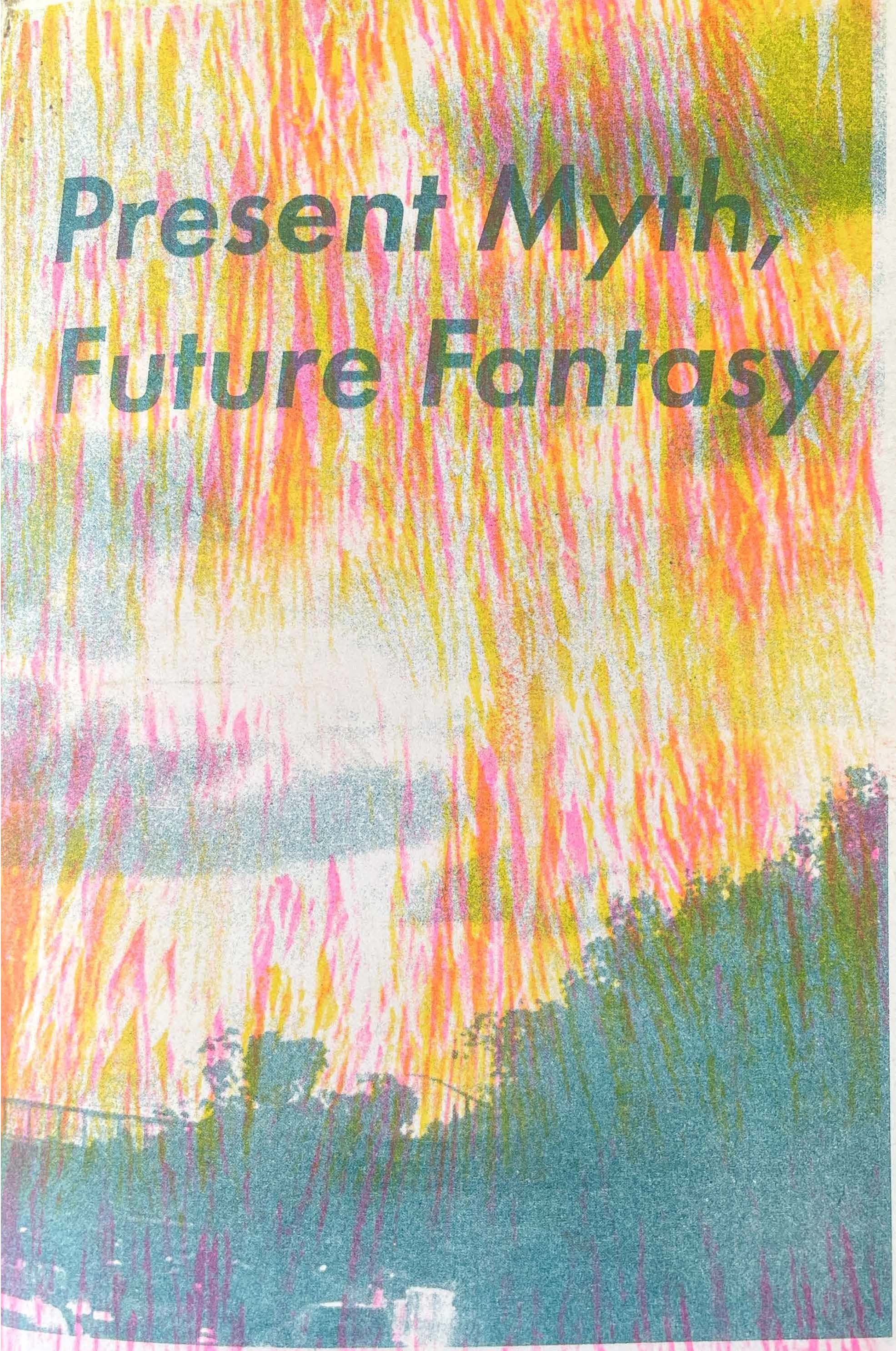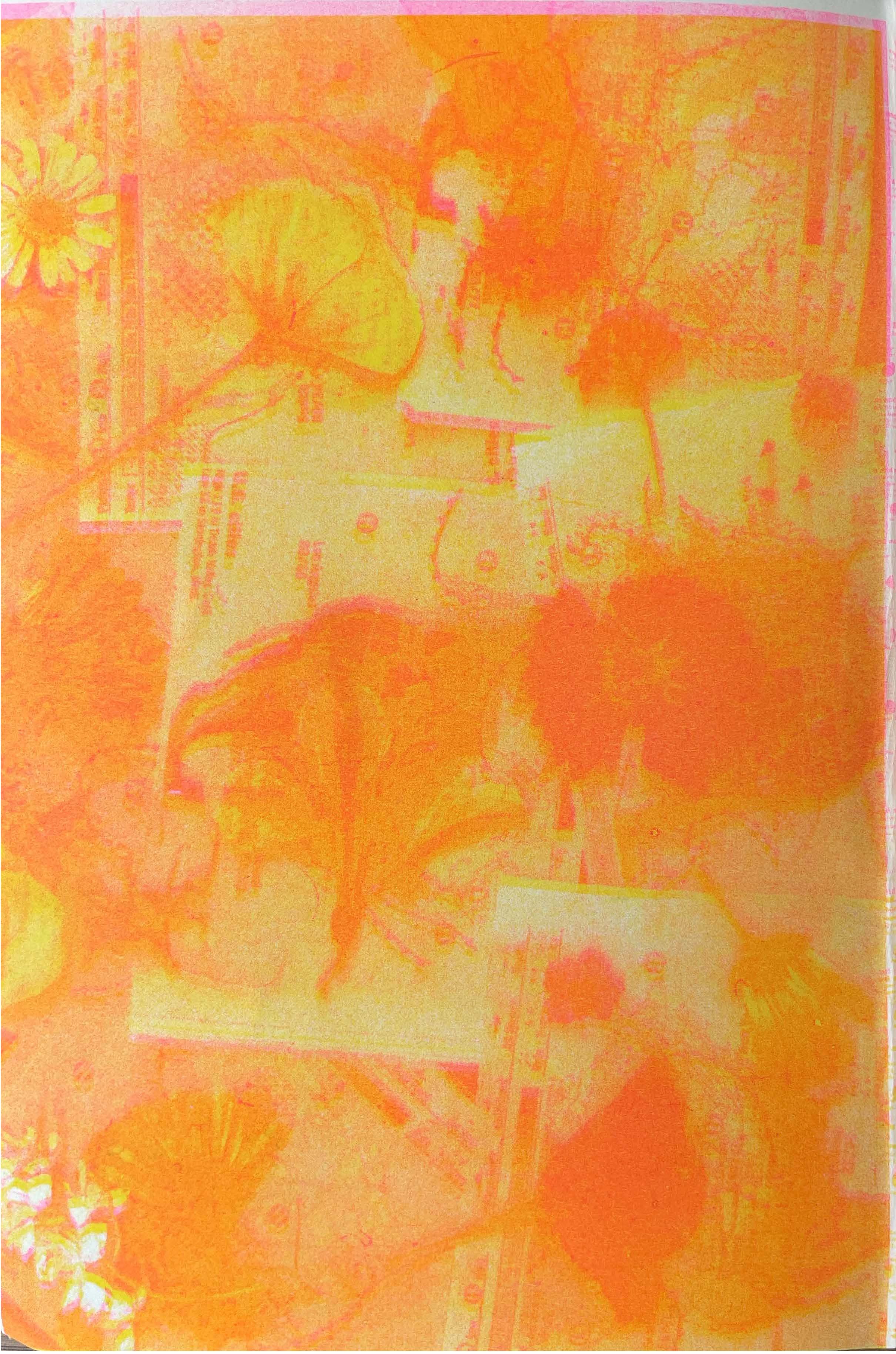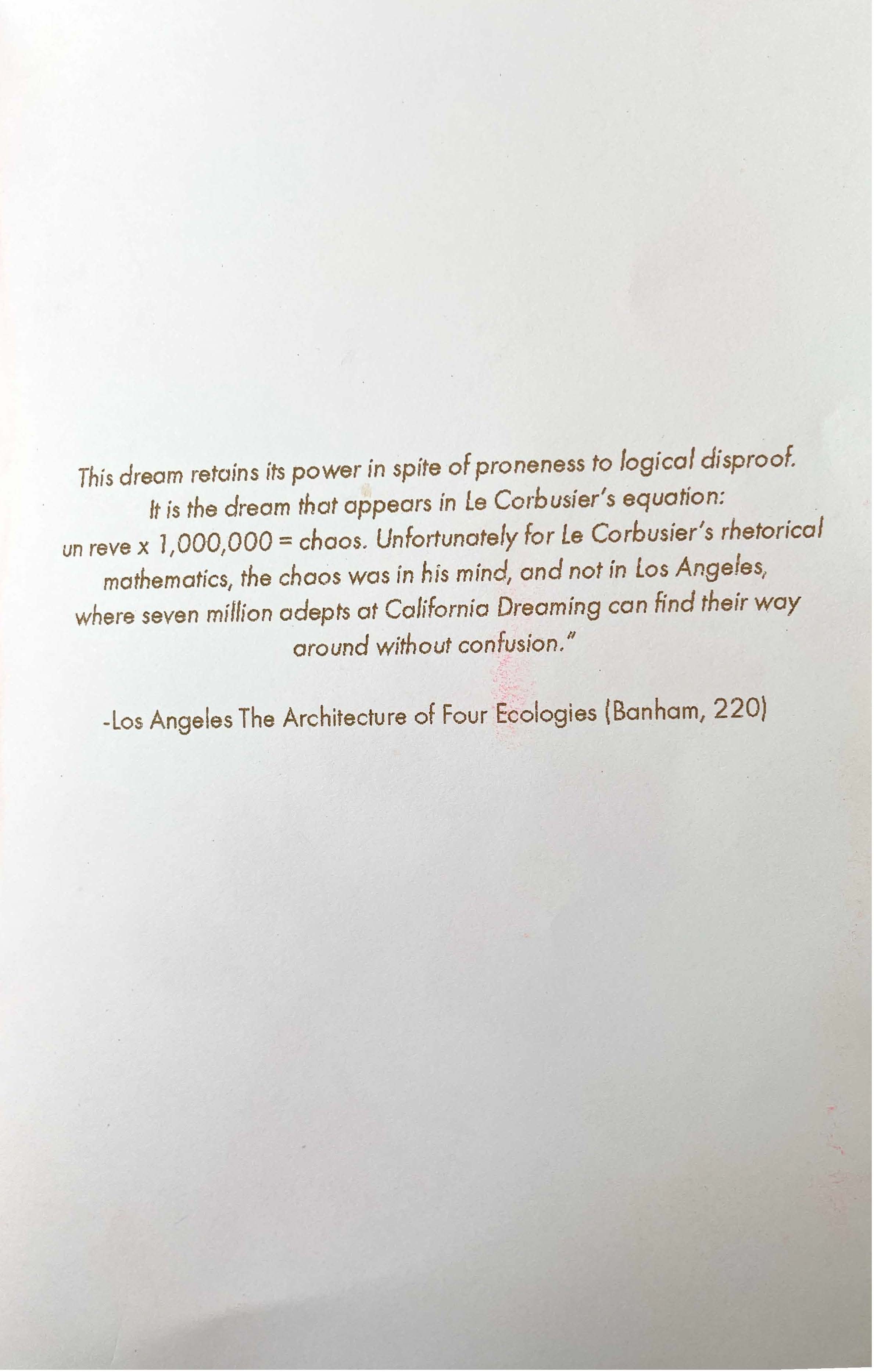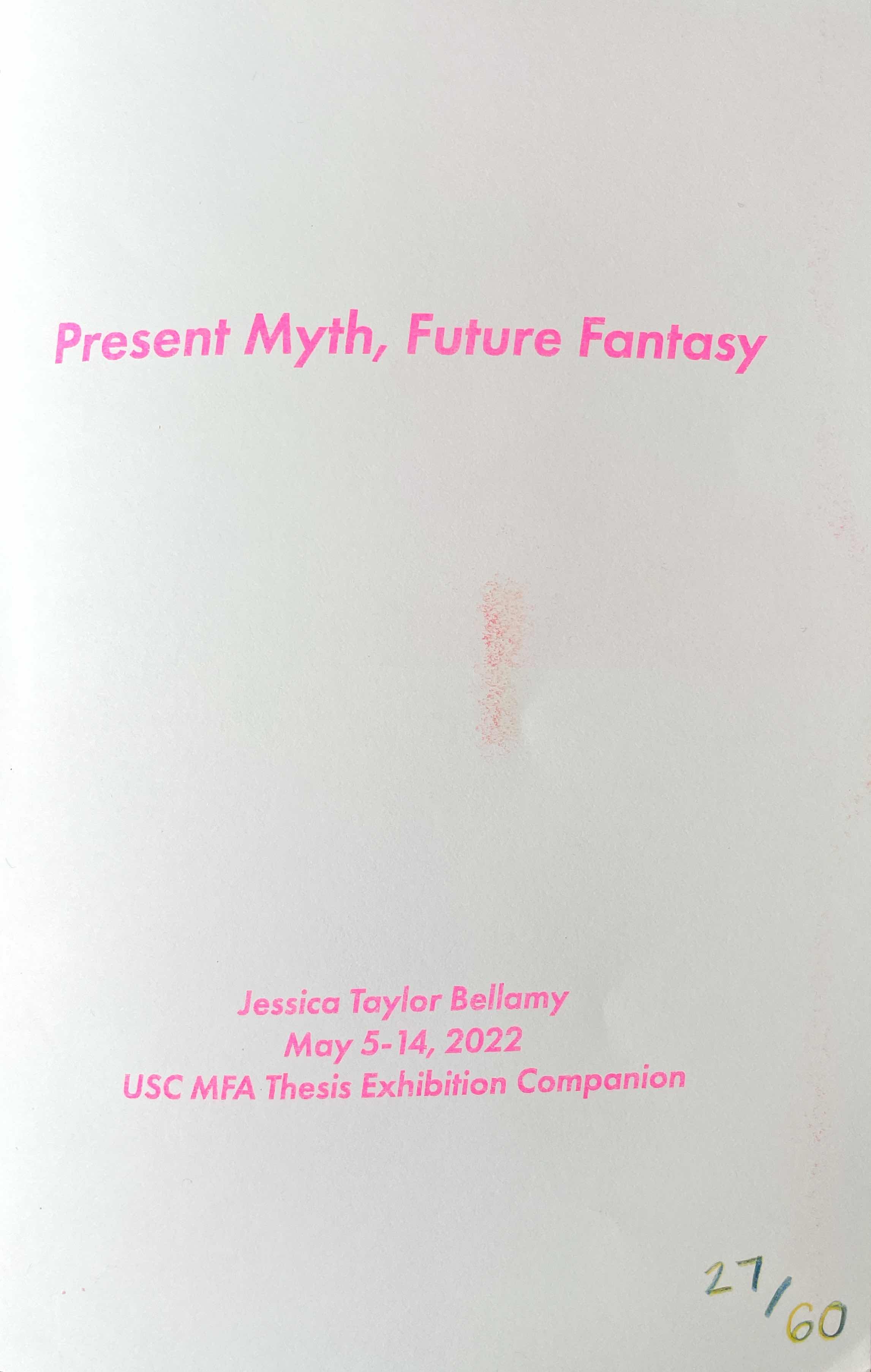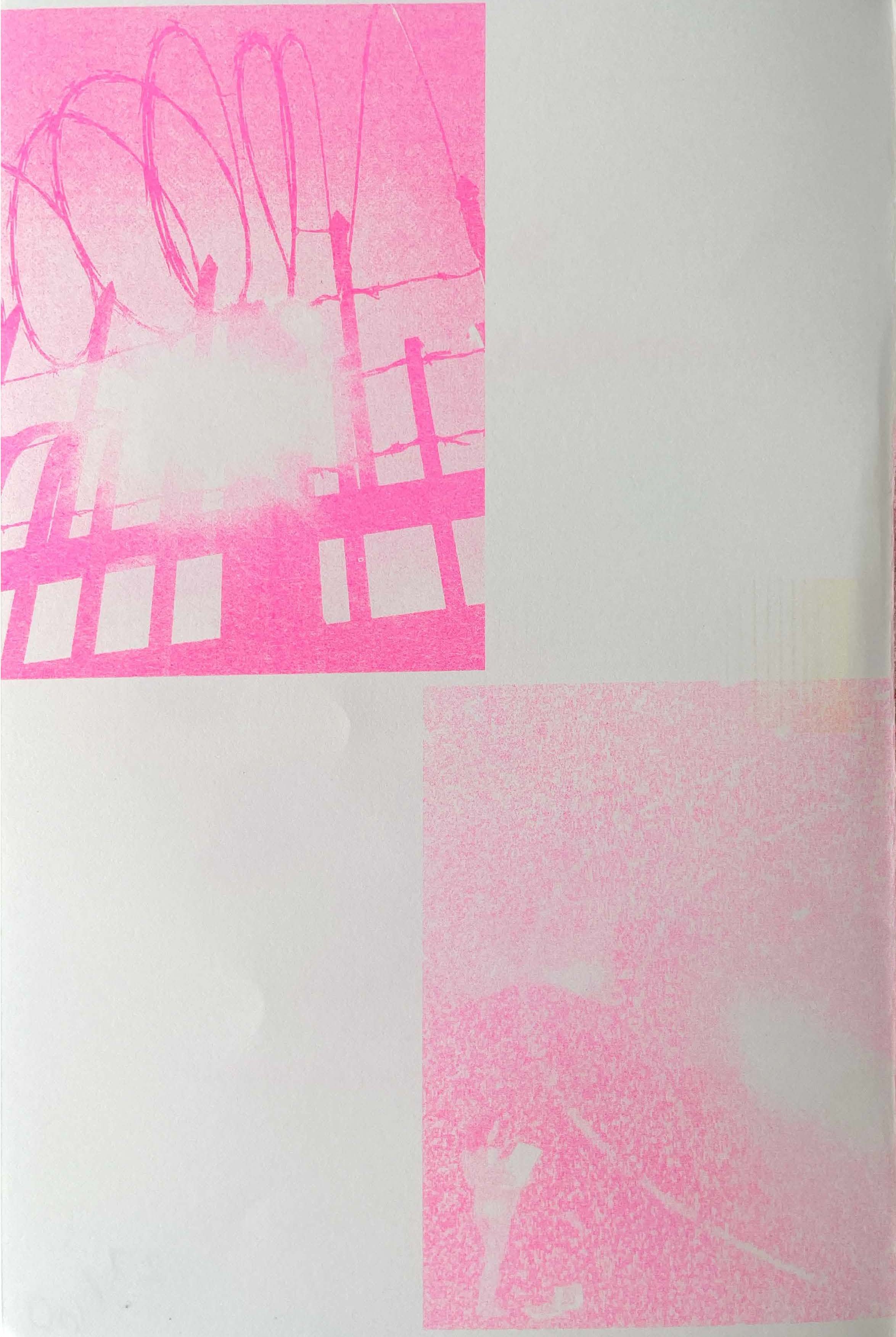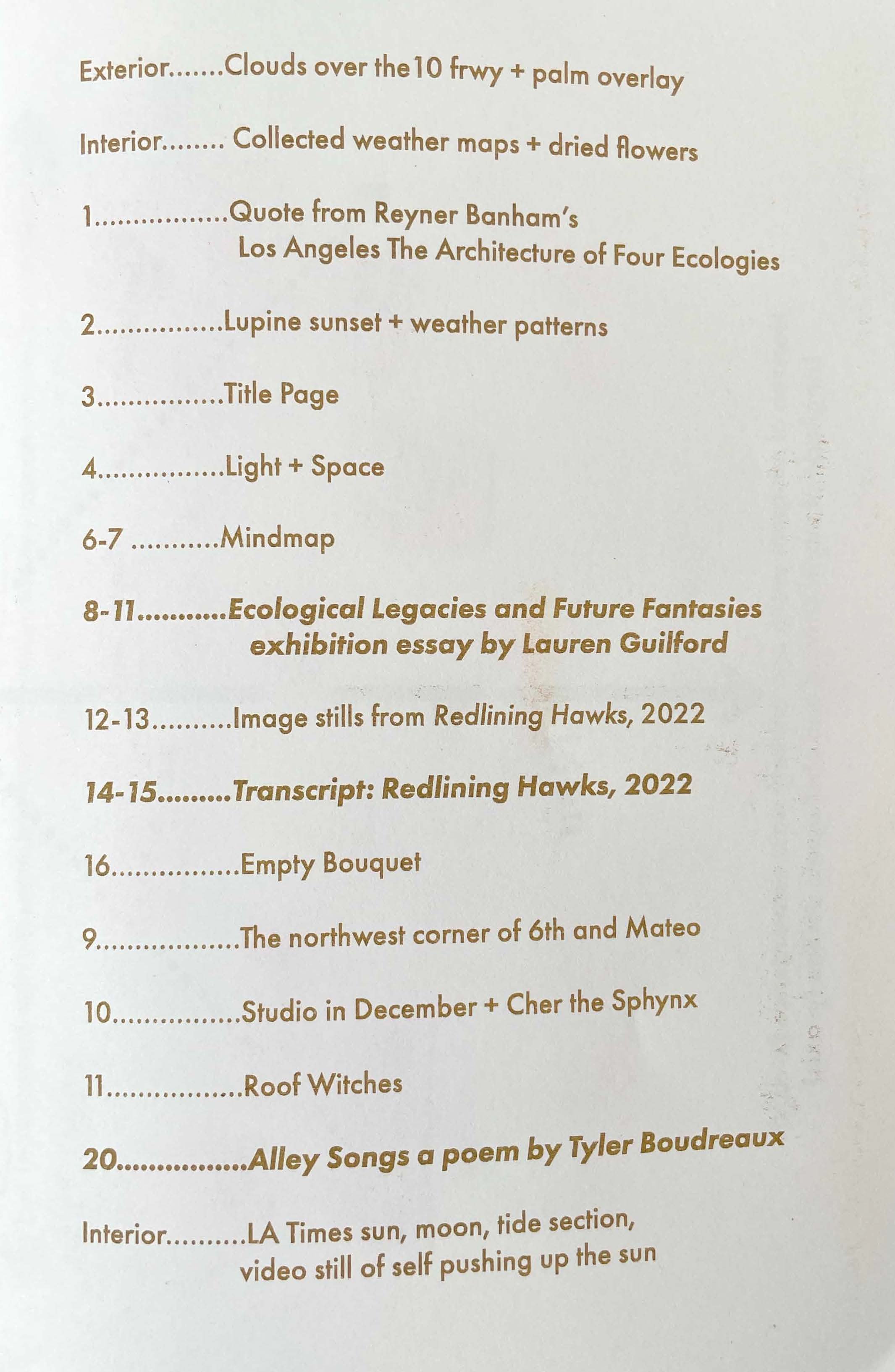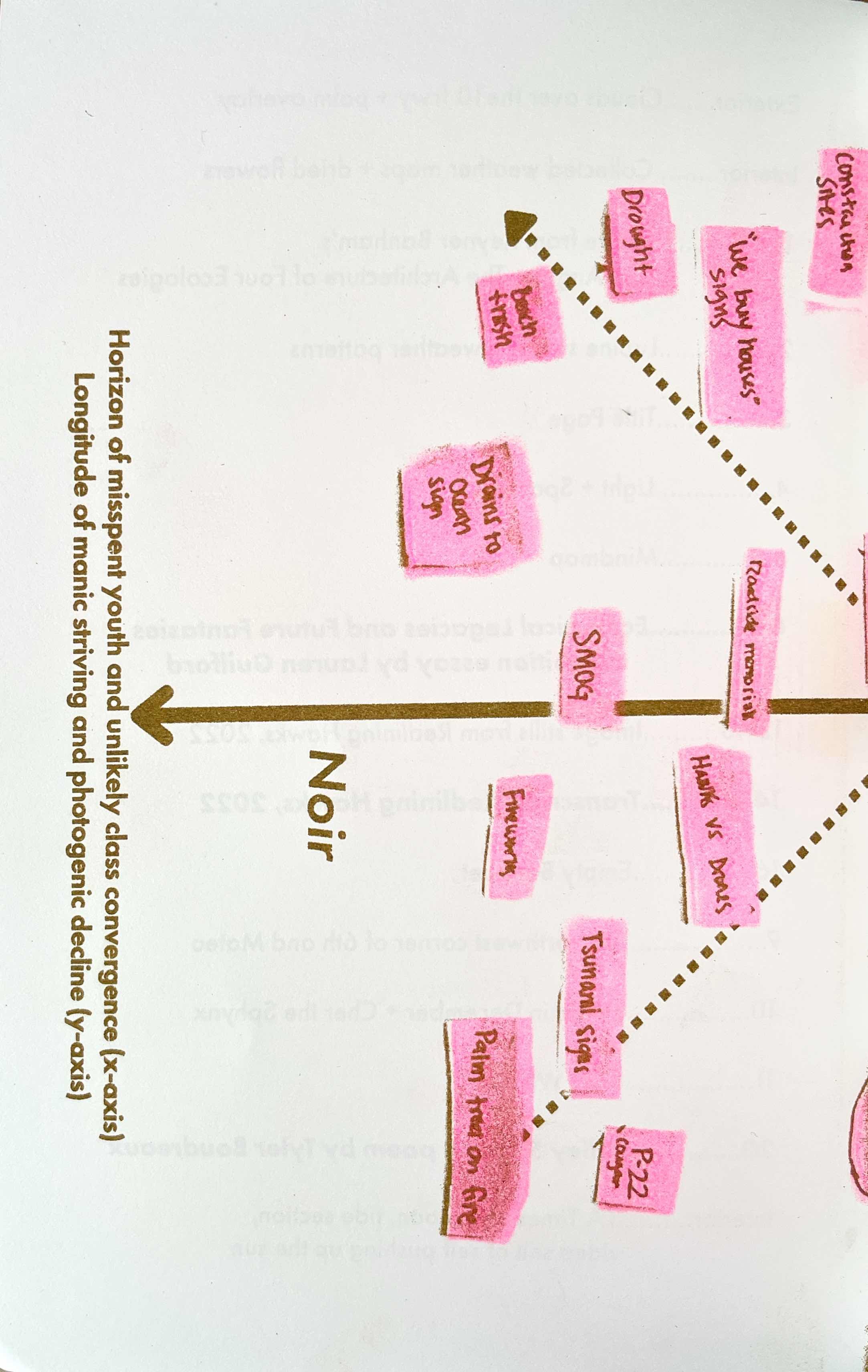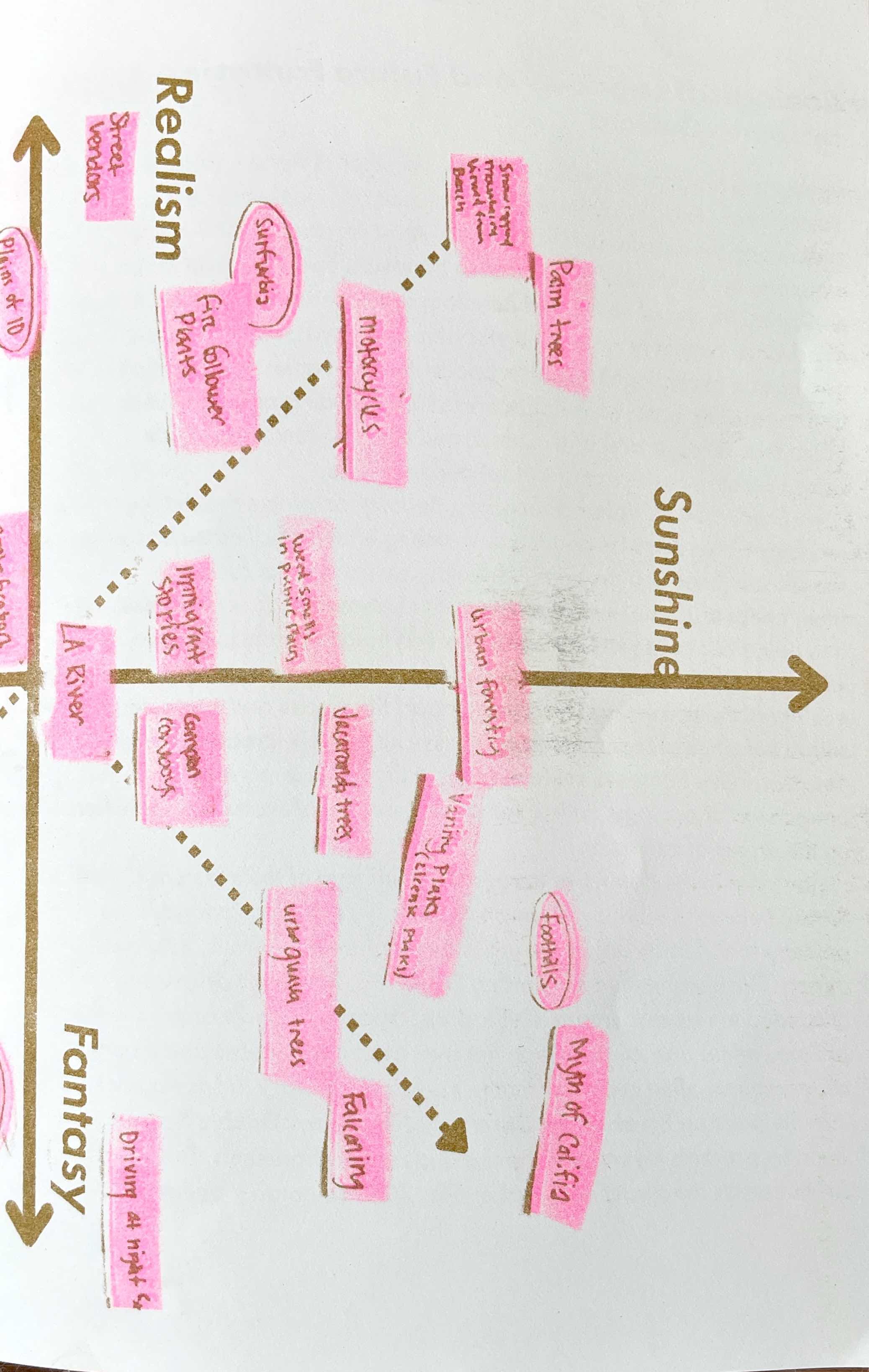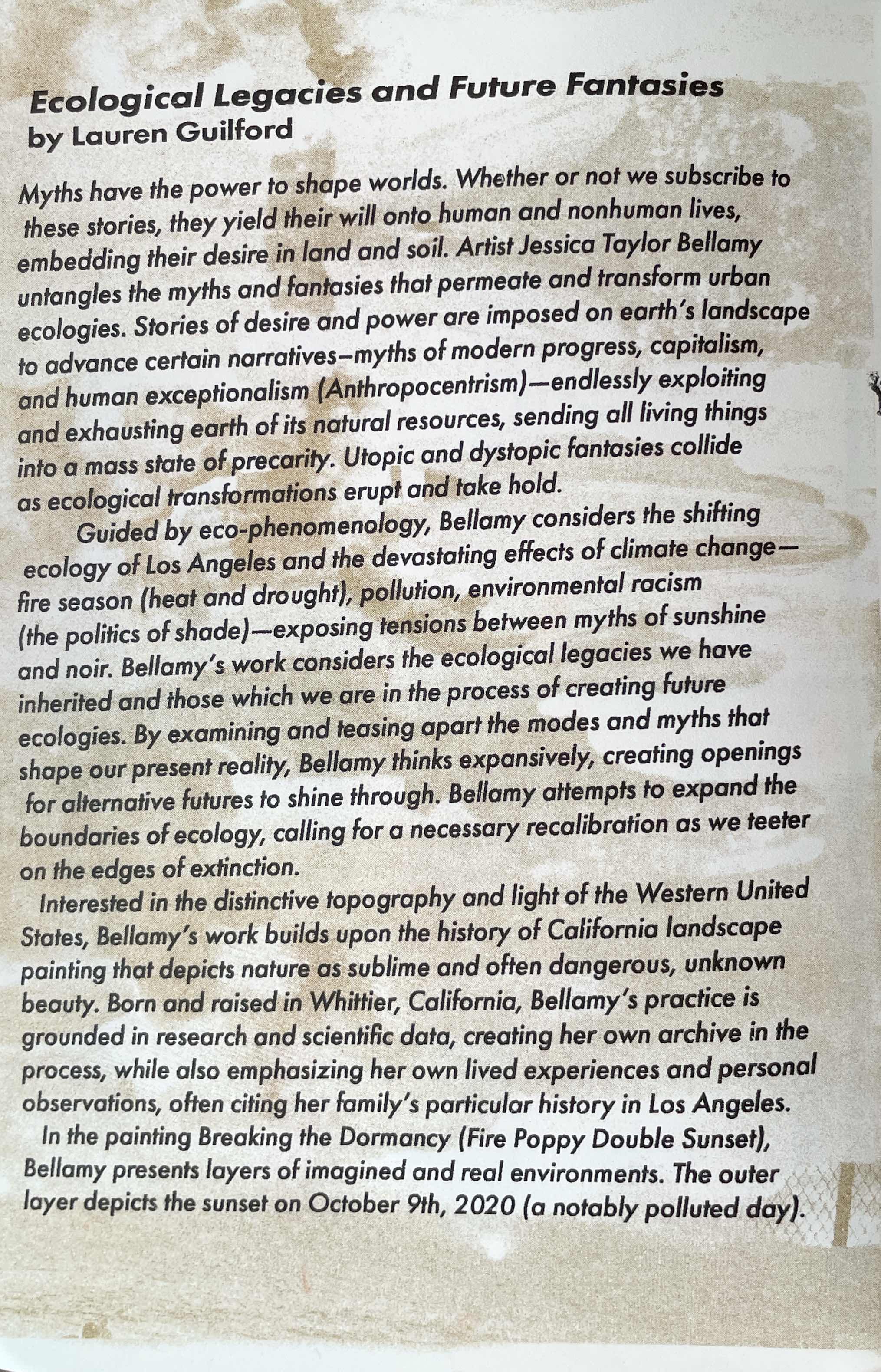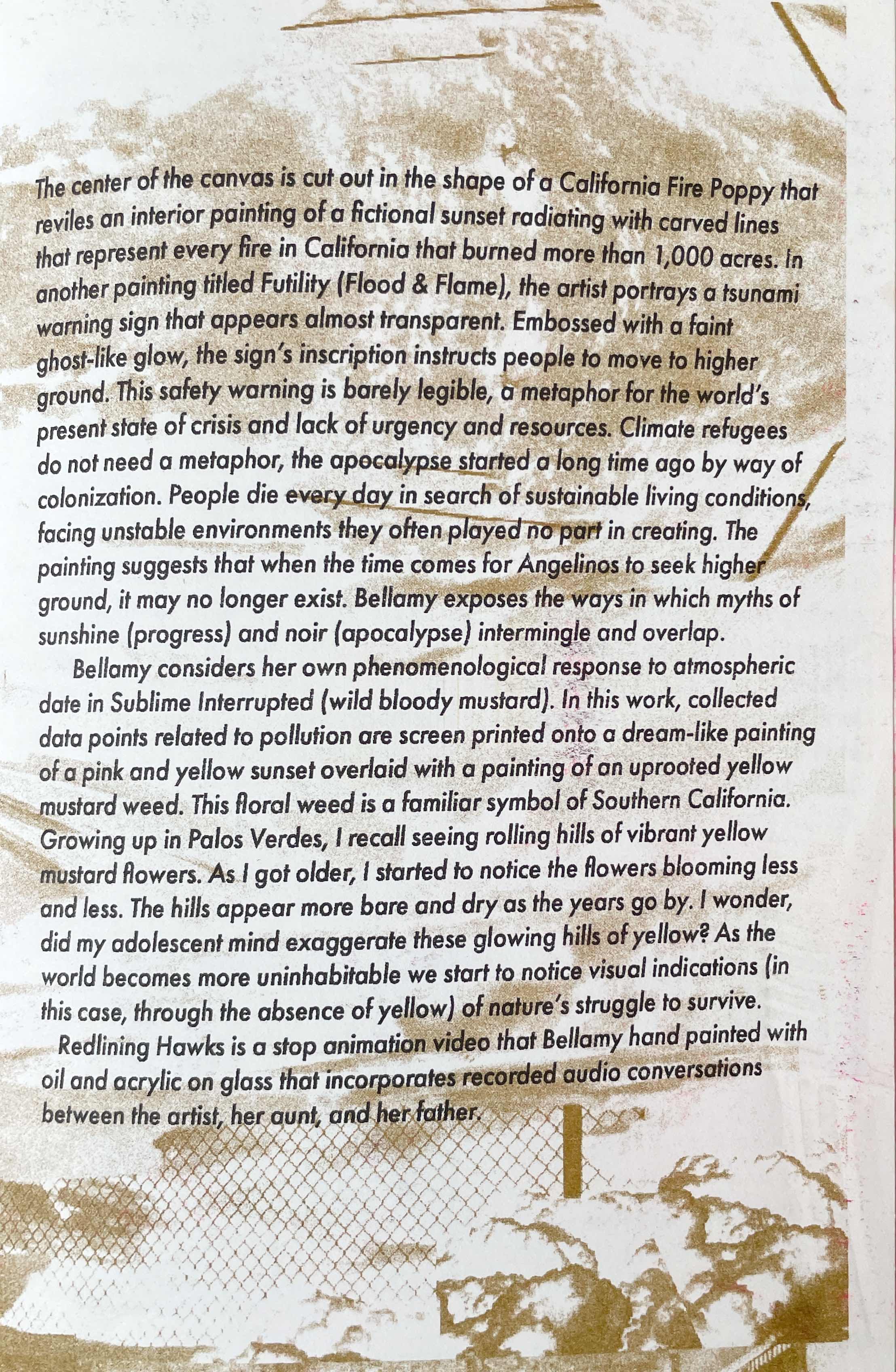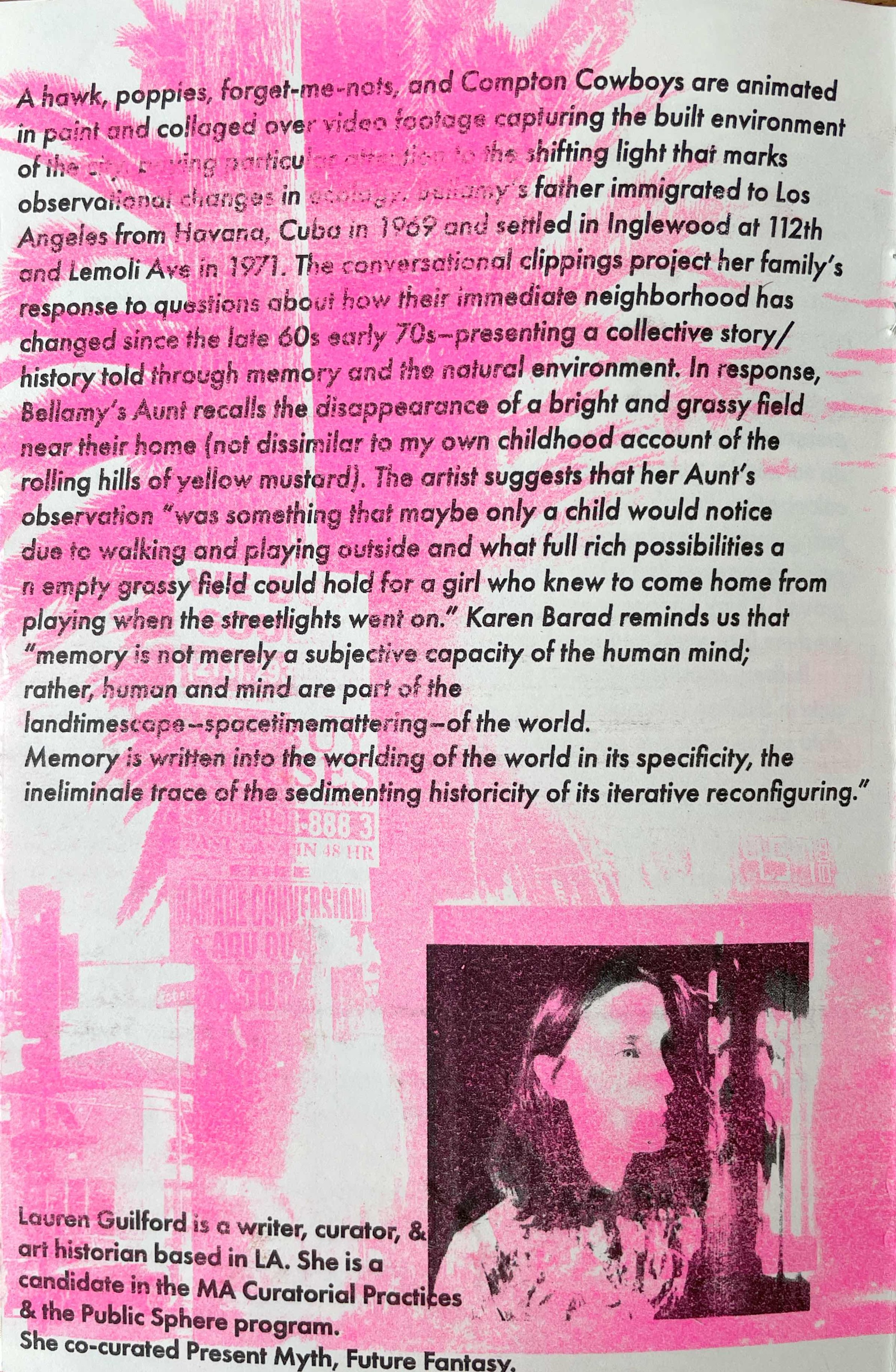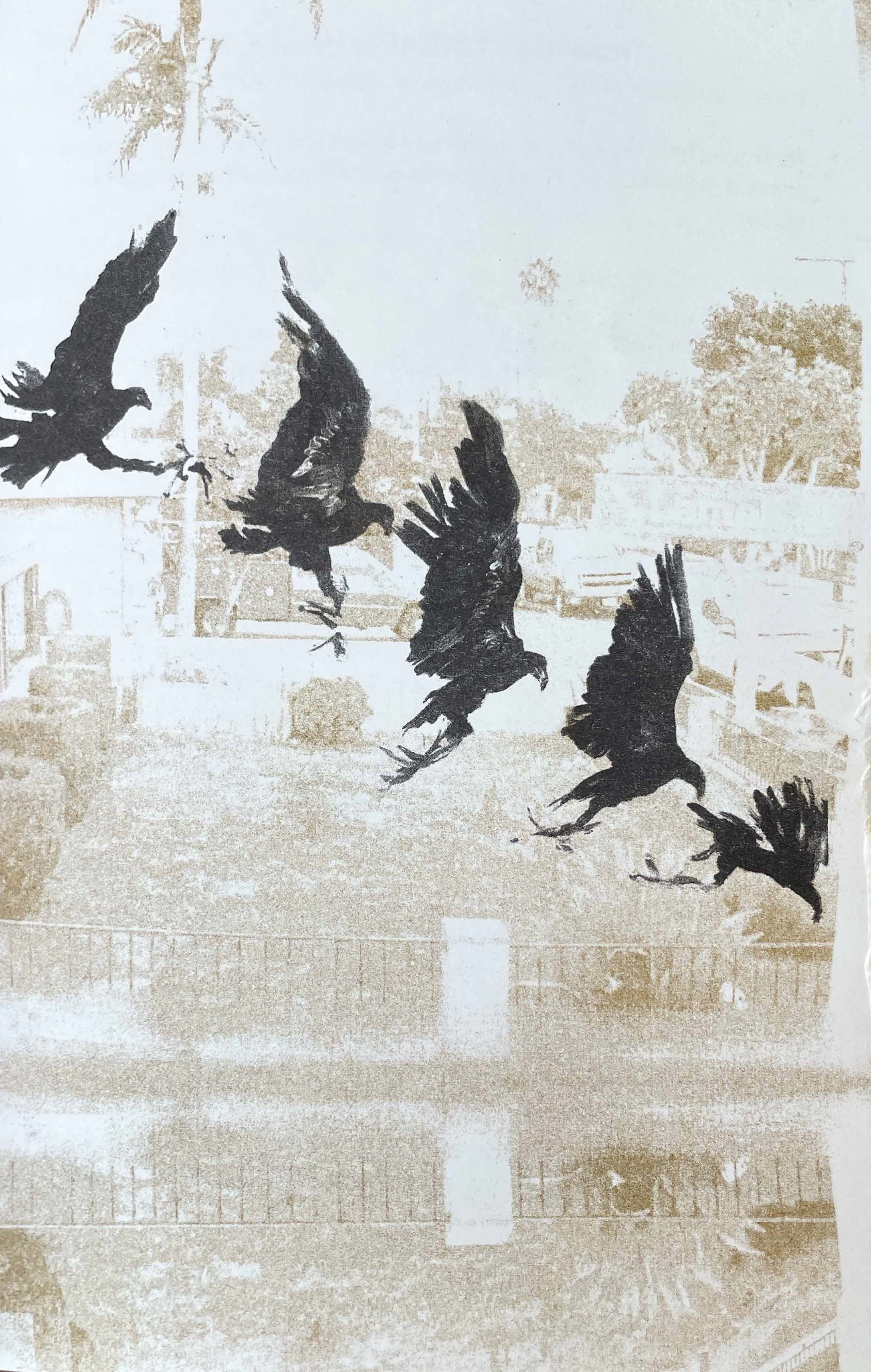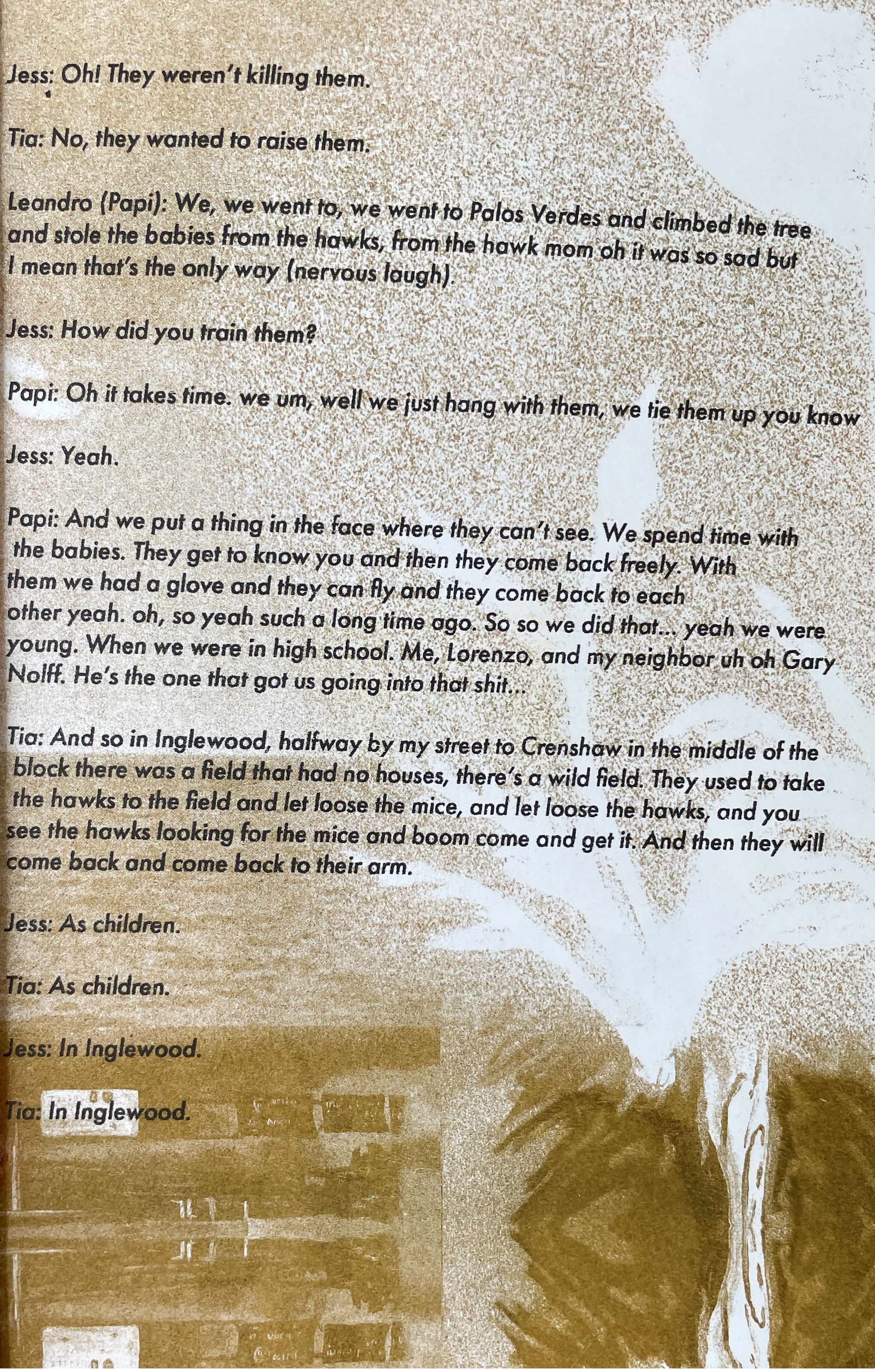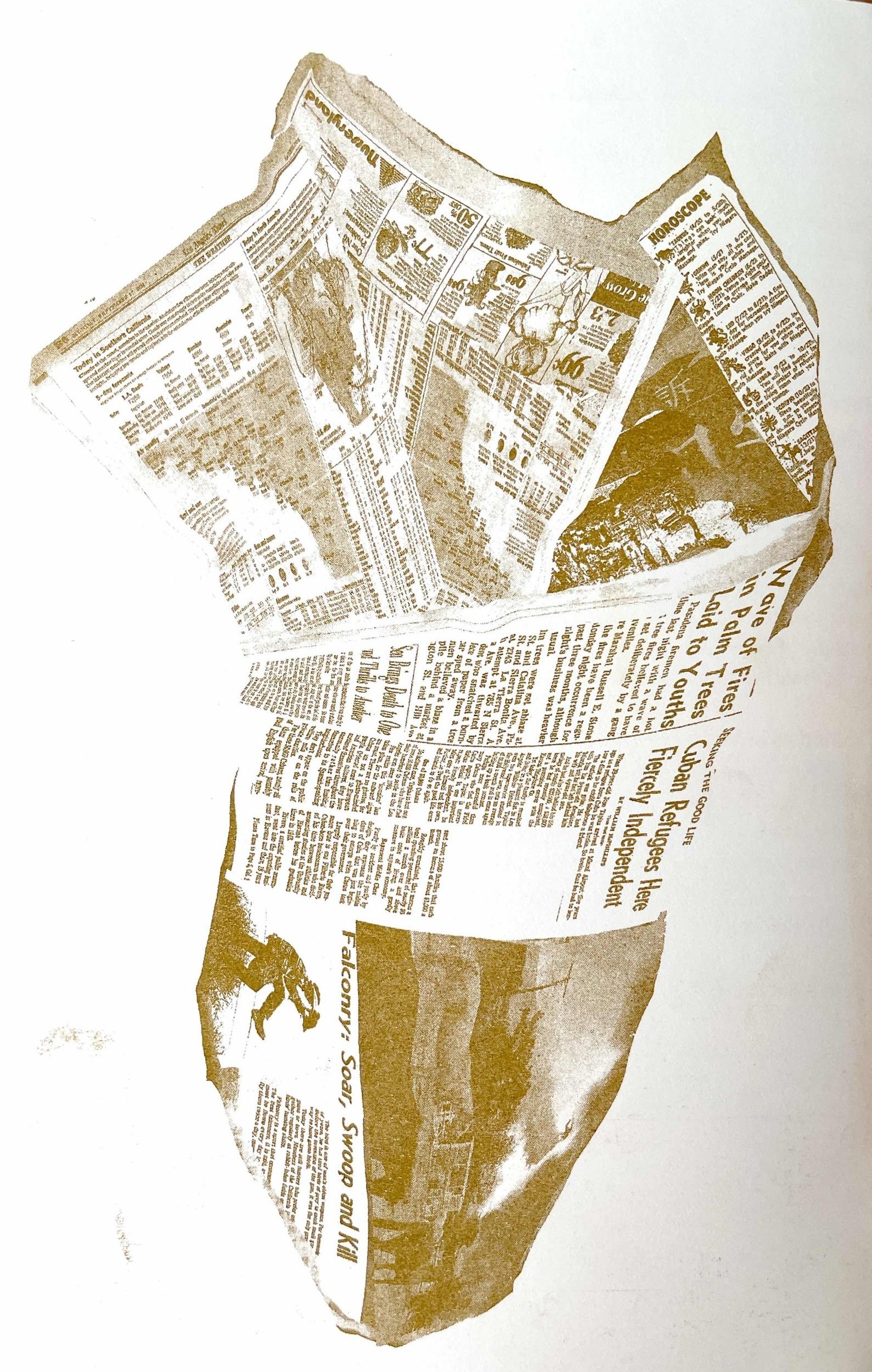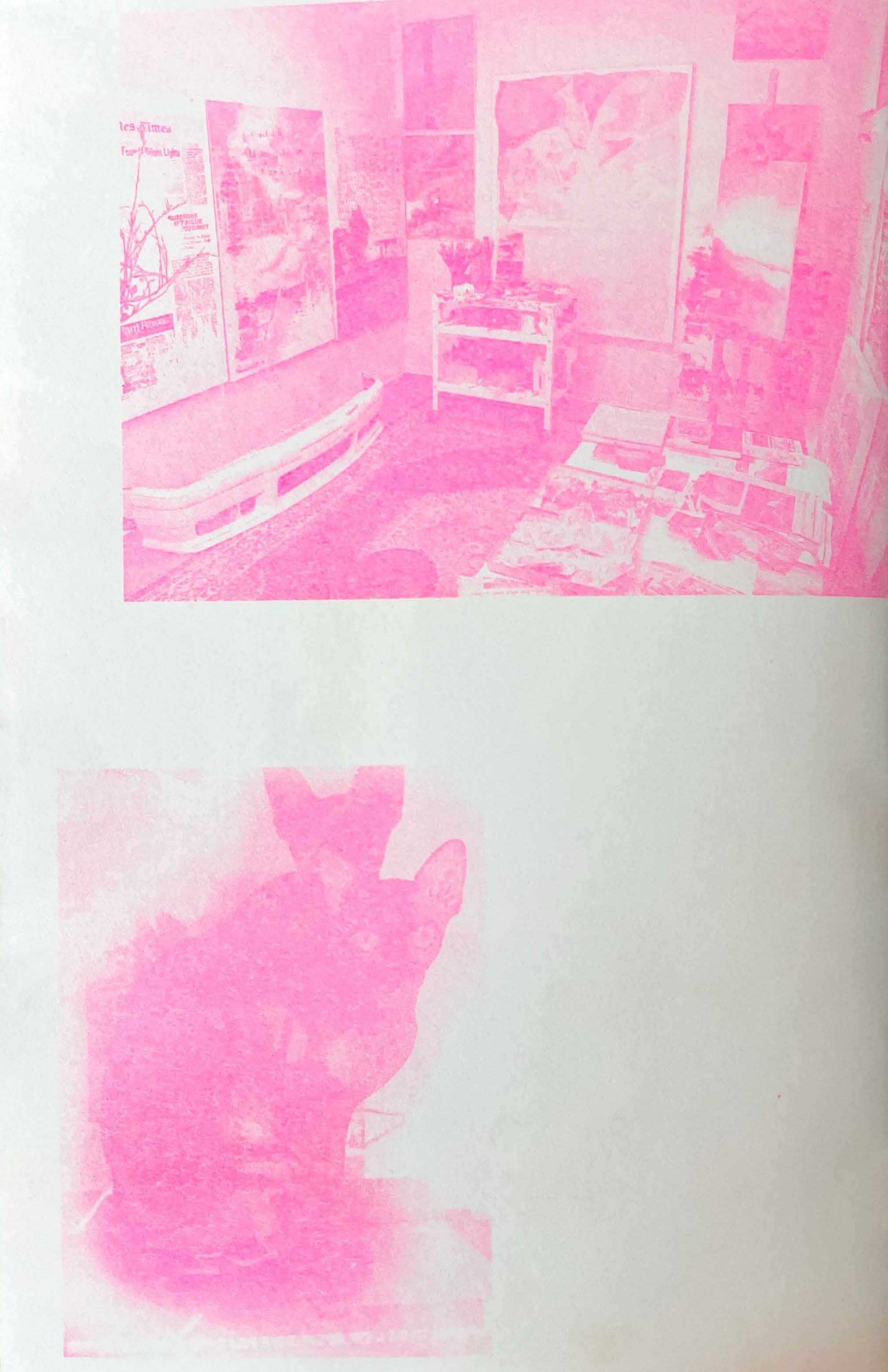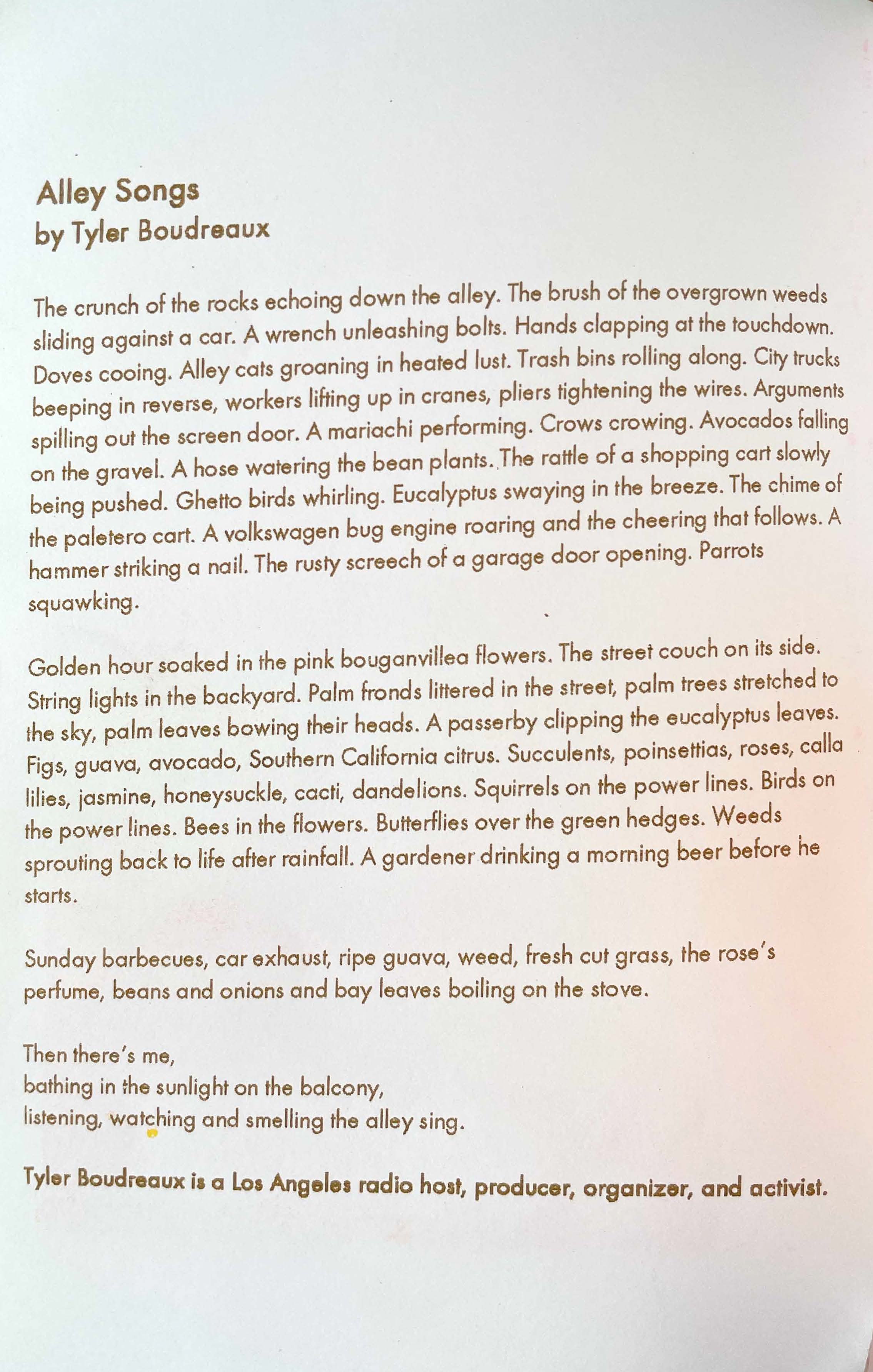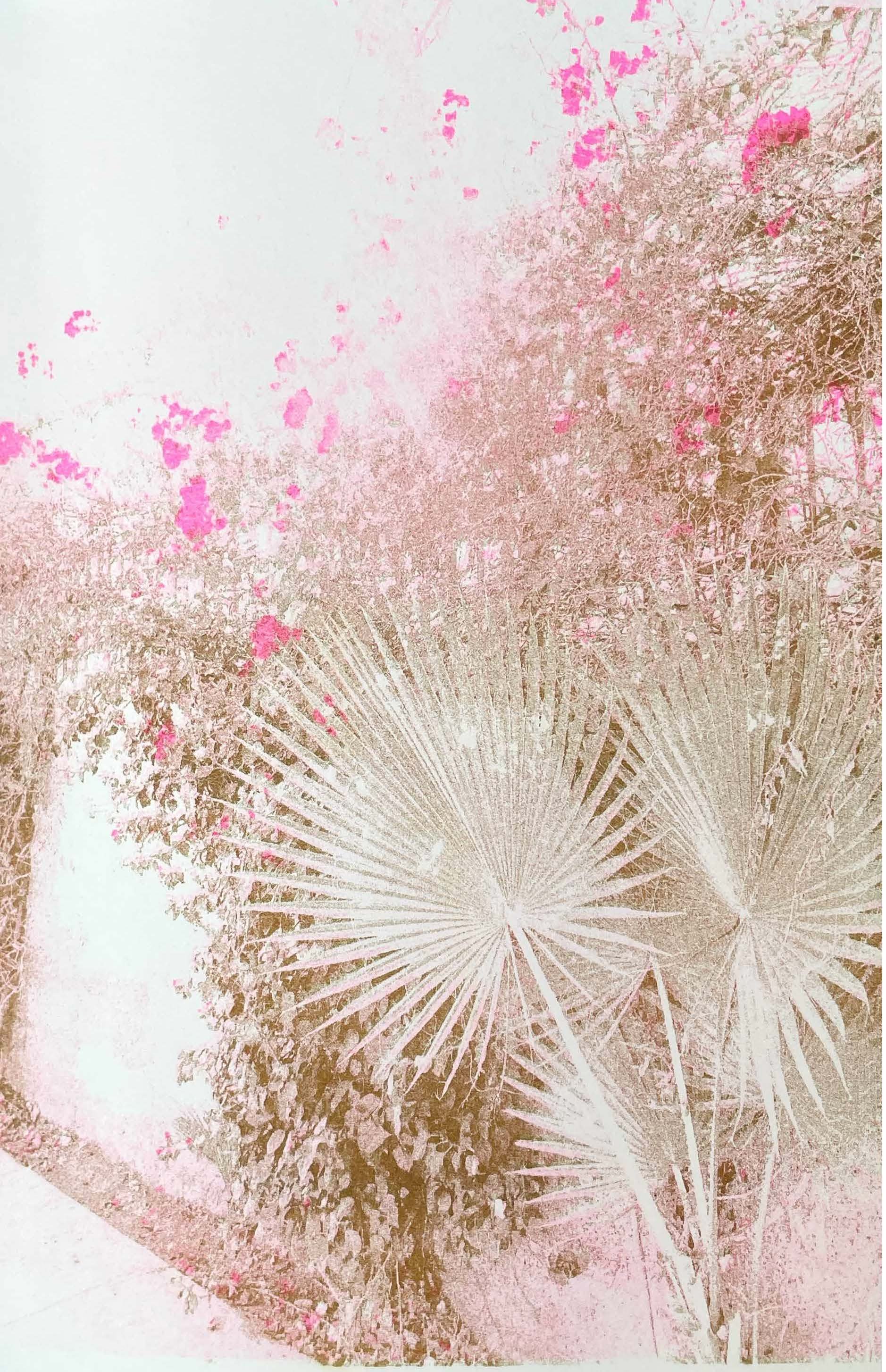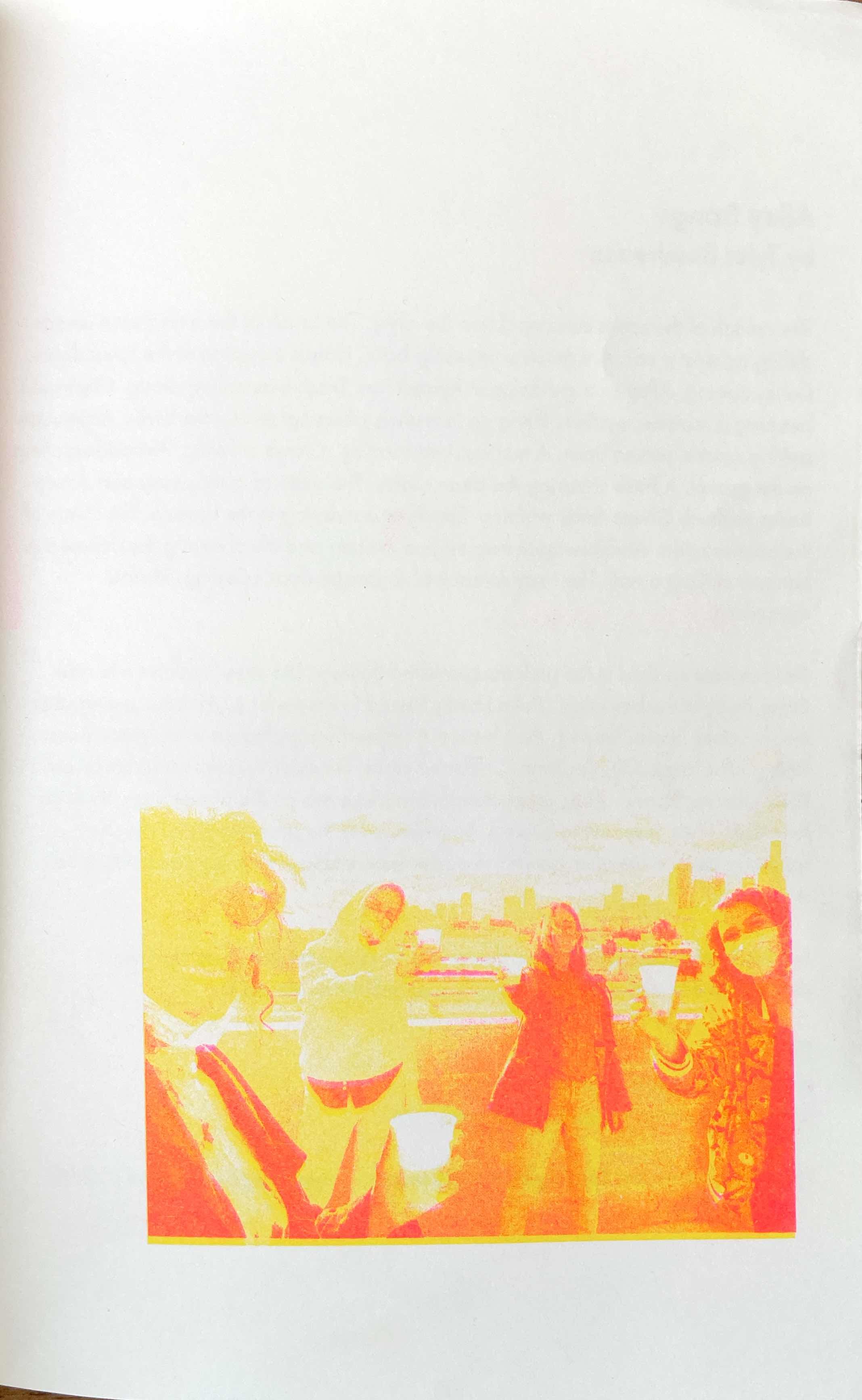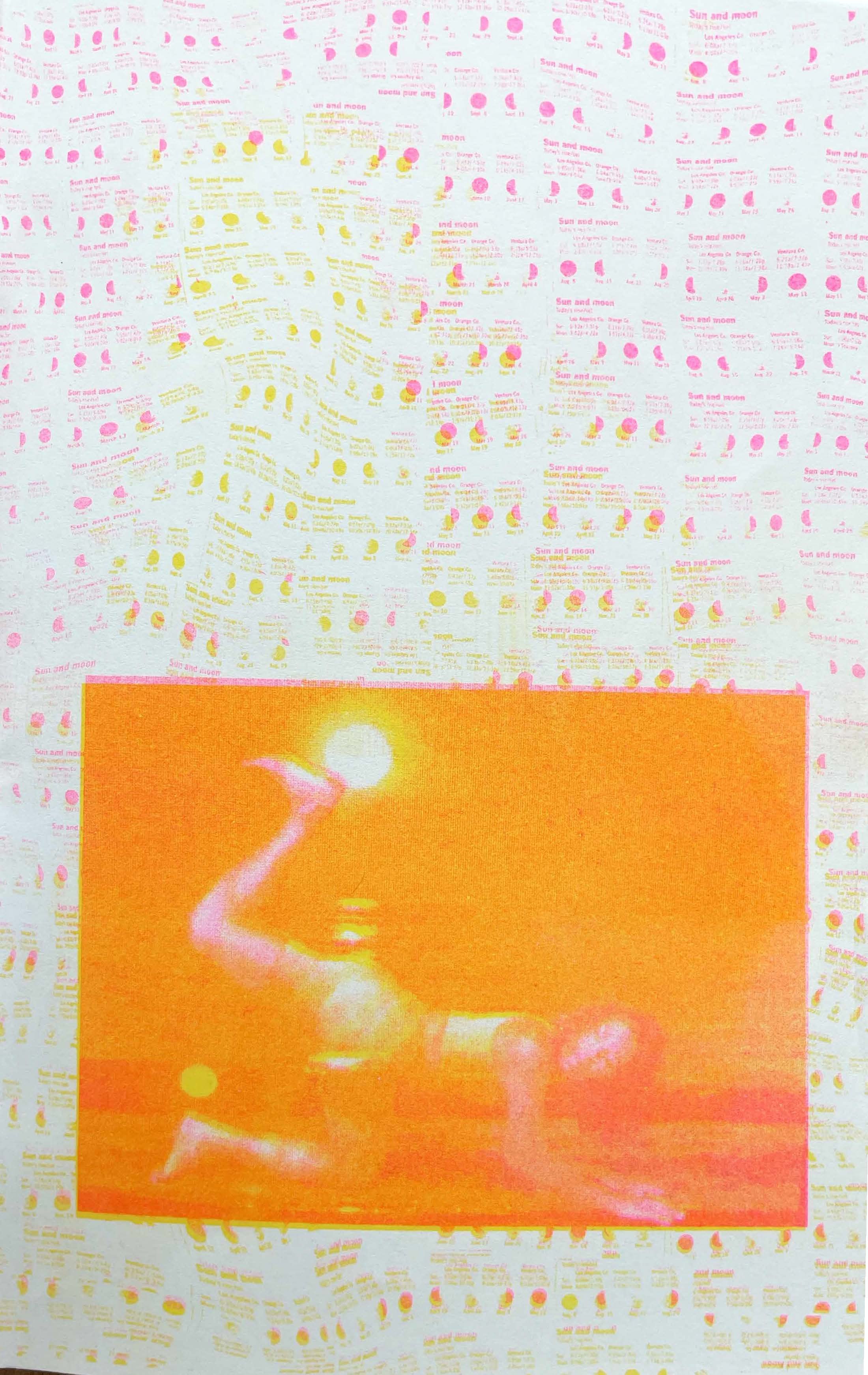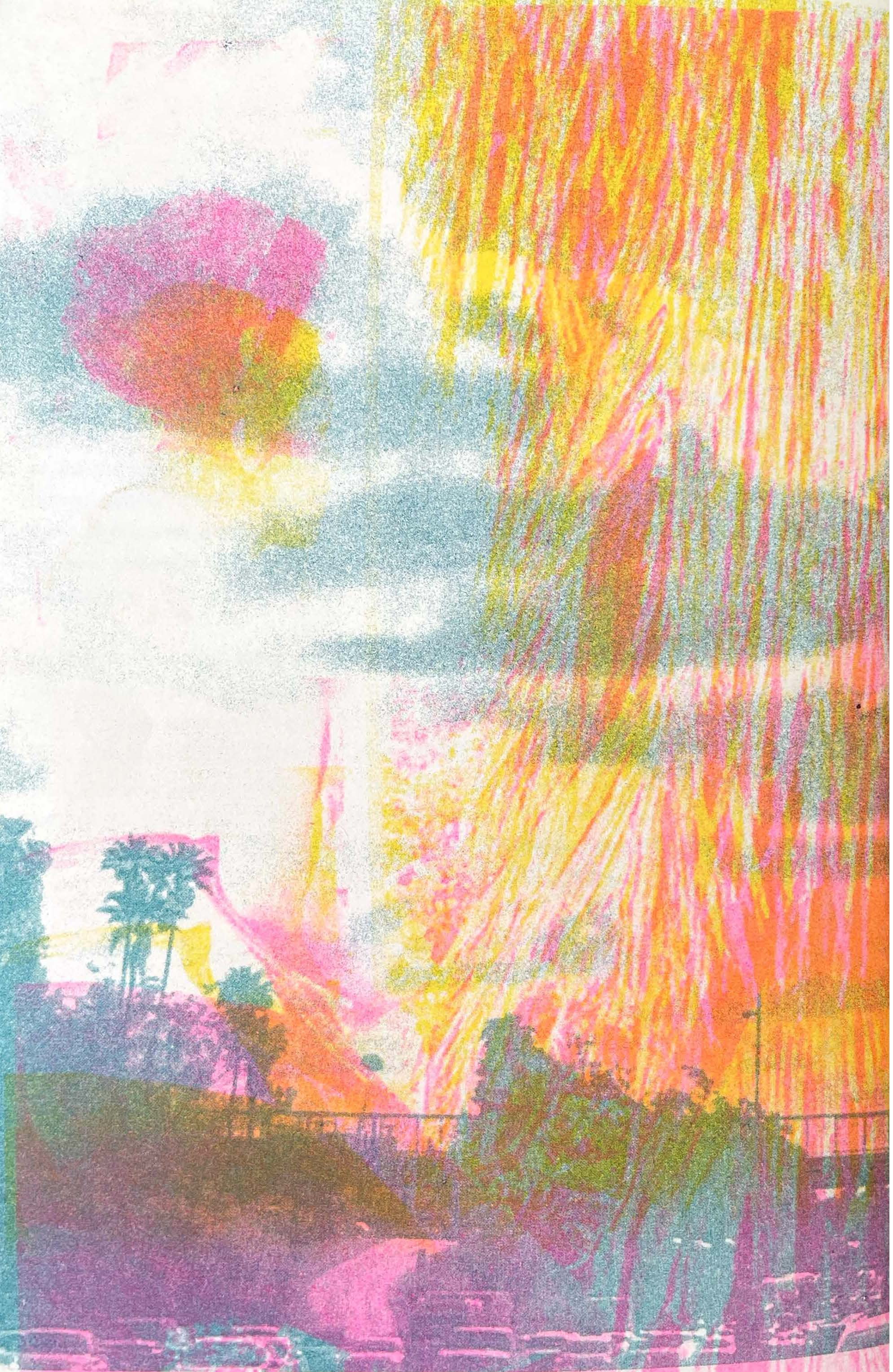Present Myth, Future Fantasy - Scan of Risograph Companion Zine - Edition of 60 - May 6, 2022
The following book was handmade by the artist as a companion to her solo MFA exhibition titled Present Myth, Future Fantasy. Jessica Taylor Bellamy uses the California landscape, collected data from the LA Times, and photos of where reality meets fantasy. This includes studies and iconography for her paintings and her screen prints, and emphasizes the physical labor involved in their making. The images in the book capture the themes of light, heat, pollution, beauty, studio musings in the form of a mindmap, freeways, rooftops. The text included the book includes a show essay by Lauren Guilford, poetry by Tyler Boudreaux, and a quote from Reyner Banahm’s Los Angeles: The Architecture of Four Ecologies, as well as the transcript for the short film Redlining Hawks (an animated memory), 2022.
Ecological Legacies and Future Fantasies
05.05.2022
Essay by Lauren Guilford
Myths have the power to shape worlds. Whether or not we subscribe to these stories, they yield their will onto human and nonhuman lives, embedding their desire in land and soil. Artist Jessica Taylor Bellamy untangles the myths and fantasies that permeate and transform urban ecologies. Stories of desire and power are imposed on earth’s landscape to advance certain narratives–myths of modern progress, capitalism, and human exceptionalism (Anthropocentrism)—endlessly exploiting and exhausting earth of its natural resources, sending all living things into a mass state of precarity. Utopic and dystopic fantasies collide as ecological transformations erupt and take hold.
Guided by eco-phenomenology, Bellamy considers the shifting ecology of Los Angeles and the devastating effects of climate change—fire season (heat and drought), pollution, environmental racism (the politics of shade)—exposing tensions between myths of sunshine and noir. Bellamy’s work considers the ecological legacies we have inherited and those which we are in the process of creating future ecologies. By examining and teasing apart the modes and myths that shape our present reality, Bellamy thinks expansively, creating openings for alternative futures to shine through. Bellamy attempts to expand the boundaries of ecology, calling for a necessary recalibration as we teeter on the edges of extinction.
Interested in the distinctive topography and light of the Western United States, Bellamy’s work builds upon the history of California landscape painting that depicts nature as sublime and often dangerous, unknown beauty. Born and raised in Whittier, California, Bellamy’s practice is grounded in research and scientific data, creating her own archive in the process, while also emphasizing her own lived experiences and personal observations, often citing her family’s particular history in Los Angeles.
In the painting Breaking the Dormancy (Fire Poppy Double Sunset), Bellamy presents layers of imagined and real environments. The outer layer depicts the sunset on October 9th, 2020 (a notably polluted day). The center of the canvas is cut out in the shape of a California Fire Poppy that reviles an interior painting of a fictional sunset radiating with carved lines that represent every fire in California that burned more than 1,000 acres. In another painting titled Futility (Flood & Flame), the artist portrays a tsunami warning sign that appears almost transparent. Embossed with a faint ghost-like glow, the sign’s inscription instructs people to move to higher ground. This safety warning is barely legible, a metaphor for the world’s present state of crisis and lack of urgency and resources. Climate refugees do not need a metaphor, the apocalypse started a long time ago by way of colonization. People die every day in search of sustainable living conditions, facing unstable environments they often played no part in creating. The painting suggests that when the time comes for Angelinos to seek higher ground, it may no longer exist. Bellamy exposes the ways in which myths of sunshine (progress) and noir (apocalypse) intermingle and overlap.
Bellamy considers her own phenomenological response to atmospheric data in Sublime Interrupted (wild bloody mustard). In this work, collected data points related to pollution are screen printed onto a dream-like painting of a pink and yellow sunset overlaid with a painting of an uprooted yellow mustard weed. This floral weed is a familiar symbol of Southern California. Growing up in Palos Verdes, I recall seeing rolling hills of vibrant yellow mustard flowers. As I got older, I started to notice the flowers blooming less and less. The hills appear more bare and dry as the years go by. I wonder, did my adolescent mind exaggerate these glowing hills of yellow? As the world becomes more uninhabitable, we start to notice visual indications (in this case, through the absence of yellow) of nature’s struggle to survive.
Redlining Hawks is a stop animation video that Bellamy hand painted with oil and acrylic on glass that incorporates recorded audio conversations between the artist, her aunt, and her father. A hawk, poppies, forget-me-nots, and Compton Cowboys are animated in paint and collaged over video footage capturing the built environment of the city, paying particular attention to the shifting light that marks observational changes in ecology. Bellamy’s father immigrated to Los Angeles from Havana, Cuba in 1969 and settled in Inglewood at 112th and Lemoli Ave in 1971. The conversational clippings project her family’s response to questions about how their immediate neighborhood has changed since the late 60s early 70s–presenting a collective story/ history told through memory and the natural environment. In response, Bellamy’s Aunt recalls the disappearance of a bright and grassy field near their home (not dissimilar to my own childhood account of the rolling hills of yellow mustard). The artist suggests that her Aunt’s observation “was something that maybe only a child would notice due to walking and playing outside and what full rich possibilities an empty grassy field could hold for a girl who knew to come home from playing when the streetlights went on.” Karen Barad reminds us that “memory is not merely a subjective capacity of the human mind; rather, human and mind are part of the landtimescape–spacetimemattering–of the world. Memory is written into the worlding of the world in its specificity, the ineliminale trace of the sedimenting historicity of its iterative reconfiguring.”
Bellamy considers urban forests and the politics of shade. Privilege and oppression are embedded in the topography of Los Angeles, mapped by the presence of tree coverage in predominantly white neighborhoods and lack of shade in formerly red-lined neighborhoods. Bellamy elaborates, “the borders of the old redlining maps show stark differences in canopy coverage, and much of the view and experience of the city changes for humans and animals depending on which zip or even parcel you look at.”
Los Angeles is also an ongoing construction site. This city’s constant state of transformation is captured in the multimedia installation Construction Site Portal depicting a historical redlining map of Los Angeles from 1939. The canvas is sliced open “to reveal a window or a portal to a real, yet different and more fantastic reality.” Inspired by a sewage construction site near Bellamy’s house in Marina Del Rey, the installation consists of a fence and enclosed canvas that reveals an imagined map of urban tree coverage the artist describes as “a dream; a goal to help mitigate the combination of intense light, drought, and heat on those living in areas without coverage.” Bellamy’s dream is an example of Black radical imagination. As Kara Keeling notes in Queer Times, Black Futures, “the imagination participates in the construction of the present through a combination of past and present elements that are not necessarily perceptible reality.” The installation titled Ecology IV: Horizon of Manic Striving and Photogenic Decline also presents a fantasy that imagines a counter-culture to the hyper-masculine car craze in Los Angeles in the 1960s and 1970s
Simon O’Sullivan writes about the ways in which landscape is fictionalized and operates to produce myth, stating that “images and narrative can be overlaid on a given terrain in order to animate it in different ways.” Bellamy untangles these myths while also projecting her own dreams and hopes for alternative futures. When humans no longer inhabit the earth, light will remain—shining down on the wreckage and ruins of human dreams and desires, allowing new life to bloom in our absence.
Lauren Guilford is a writer, curator, and art historian based in LA. She is a candidate in the MA Curatorial Practices in the Public Sphere program. She co-curated Present Myth, Future Fantasy.
Publisher - SelfCity - Los AngelesYear - 2022Pages - [24pg]Dimensions - 8x10 inchesCover - PaperbackPaper - Cougar Natural 80lbBinding - Staple BoundProcess - RisographColors - Teal, Fluorescent Pink, Yellow,Flat Gold, Black
